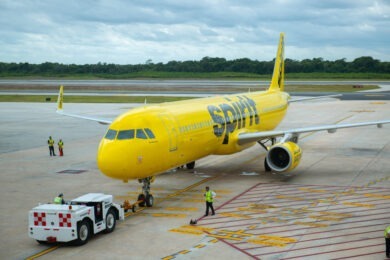Speculations circled overhead at the pandemic’s genesis that the business travel industry ought to fear an irreparable nosedive. In the face of doubt, however, business travel has emerged with critical and pivotal strategies for recovery in its pocket and a renaissance of travel in its sights, as evidenced by American Express Global Business Travel (GBT)’s white paper, “Why Business Travel Is the Center of the New Company Culture.”
The white paper, released in mid-May, highlighted the pivotal role business travel is poised to play in building business back. With employees distributed cross-continentally after a two-year hiatus from face-to-face, company cultures have fragmented, said GBT, but not necessarily fractured. Employee needs and priorities have changed, organizations are refocusing their missions and business models and, thus, roles are changing too.
GBT found that business travel is far from crushed under the weight of shifting business goals, and instead, is taking new shape as a prime and prepared vessel for reinvigorating inclusive, successful company cultures.
The Great Reprioritization
How businesses and their leaders rethink and rework business goals, and the initiatives and new policies they enact have the power to draw companies back together, connect employees and restore a sense of unity. New roles have become a byproduct of this collective move to rebuild company cultures—cultures that are valued because they value those who belong to it.
GBT partnered with CULTIQUE for its strategic cultural advisement as the global travel management organization (TMO) guides the morphing industry into becoming a “transformational tool.” “We’ve witnessed the emergence of chief data officers, chief diversity officers and even chief wellness officers—all roles demonstrating a clear reprioritization of new areas,” observed CULTIQUE co-founder Sarah Unger.
The role of the travel manager has expanded, and with it, the role of the planner. For travel managers (and meeting professionals), the job requires agility, delicate planning, awareness, intention over expenses and duty of care. The heightened intensity of some of these nonnegotiable, not even entirely new skills, however, comes from a place of more conscious sensitivity to client and attendee needs.
While “90% of large companies have committed to hybrid work plans [that reduce] the touch points that once conveyed company culture, for all companies, including those which never went remote, unprecedented reports of burnout are signaling that businesses must quickly adapt,” said GBT. Hybrid work plans have come at the cost of connection, but they don’t have to.
With geographically dispersed employees, opportunities for rebuilding both business travel and company cultures are gaining speed.
Read More: 7 Business Travel Trends Set to Shape 2022
Mobile Careers, Culture and a Strategy That Endures

We learned quickly how well the remote model worked. The time we saved by not commuting, the work we were able to accomplish in less time—working from home worked, until workers and businesses realized it’s not enough to just have mobile careers. Employees want an expanded, mobile culture, GBT observed.
Employees want to work for companies that align with their values and to connect with their colleagues. Focal to the evolution of company cultures is how inner teams collaborate and how well they collaborate; the execution and demonstration of thought leadership and company values by executives at events and conferences; the onboarding experience for a new employee and how employees interact with clients, as well as the travel industry’s effort to support the regrowth of company cultures.
Business concerns from retention to sustainability are being met with business travel solutions. GBT named travel “a dynamic strategy” for organizations seeking to synthesize employee connectivity and fundamental business goals.
Actionable Takeaways for Organizations and Planners
What’s going to get everyone where they want to go as we move forward is organized, collective efforts to rehabilitate company cultures. GBT found that coherency among new employees, senior leadership and executives regarding values and priorities is integral to building business back from the inside out. GBT’s paper outlines several ways travel can reinforce this movement to revitalize connection and culture in meetings and business, further exemplifying the dynamics of business travel.
Read More: At MPI WEC 2021, Michael C. Bush Laid out the Makings of a Great Workplace
Steps Toward New Cultures
According to GBT, travel programs are becoming one of the main ways remote teams meet. “More than a third of executives voice preserving company culture as their biggest hybrid work concern, [and] 82% of business travelers cite the irreplaceable value of in-person meetings,” GBT reported. While remote work has its solutions to in-person problems, employees recognize there is still a need to meet and form tangible relationships.
For instance, Salesforce introduced Trailblazer Ranch this February, a wooded California retreat designed to be an off-site for company gatherings. GBT suggested focusing on building internal team relationships at off-sites and within off-site programming, and having an active company communication channel that markets travel programming effectively.
GBT also speaks to the impact of travel on employee well-being. The corporate well-being market is expected to quadruple by 2026, GBT reported; the difference is in the shift from employee well-being efforts being viewed and treated as perks to them being implemented as reputable business strategies.
“Business trips in the future can be redesigned to demonstrate personal care and lifestyle consideration,” GBT said. The global TMO believes off-sites to be “a must-have” and an effective way to manage burnout before it becomes unmanageable. Expanding vendor deals to utilize spa facilities, wellness-based accommodation and better team training are good places to start.
“On the rise are companies shutting down for wellness weeks and ‘synchronous’ time off, offering free therapy, paying workers extra to take vacation days and partnering with corporate well-being providers,” reported GBT. The global TMO also recommends reinforcing well-being initiatives with new key performance indicators to use travel data to measure the state of employee well-being and burnout.
Moreover, travel can instigate personal development. Financial compensation and job promotions alone aren’t enough to keep employees emotionally and psychologically satisfied with their work environment. GBT listed “digital nomadism,” blended trips, four-day work weeks, sabbaticals and hotel “workspitality” spaces as business and personal development strategies are already in full force throughout the industry. Bolster your bleisure programs, pick your partners wisely by choosing venues that have co-working spaces and consider a sabbatical travel program based on individual duration of employment, suggested GBT.
Travel also increases employee autonomy. Travel doesn’t have to be a highly structured production. “Mainstream and full-time employees have become increasingly averse to strict travel policies,” noted GBT.
Instead, travel managers and meeting planners are urged to focus on minimizing friction during travel. GBT recommended giving your vendors more flexibility during your collaboration, partnering with TMOs, using corporate booking systems and asking for that critical feedback after enacting new policies.
Lastly, travel is always a way to exemplify company values—like sustainability. Values are conveyed through policies and relationships, as well as the sustainability practices of those the company chooses for their vendors, partners, location, food, fuel and tech; who you choose to invest in leaves an ecological and personal impression.
It’s also important to choose regenerative travel methods whenever you can. Diversify your supplier database, take fewer but longer trips in light of climate pressure and when possible, GBT suggested opting for electric, rental or public ground transportation.




